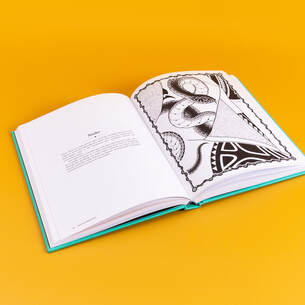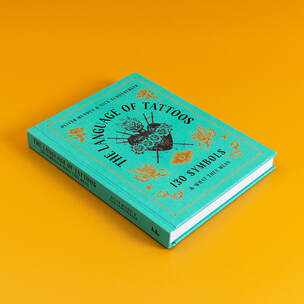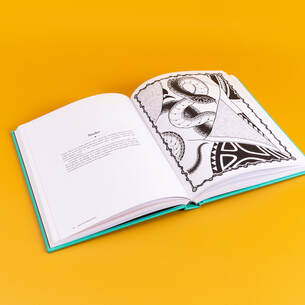|
Well, I'll be damned! Nearly four years since my last entry. I blame Brexit, Covid and the war in the Ukraine. Why not? everybody else is using those excuses. In fact, self-employment is the actual reason but, I digress, nobody cares. Out of nowhere I got invited to review "The Language of Tattoos" published by Frances Lincoln. This is 221 pages of the collaborative efforts of tattoo artist Oliver "Megamunden" Munden and tattoo expert Nick Schonberger. There are a further two pages of perfectly formed index and, if you've read my last post, you'll know how much I like an index that makes sense. So, who are these guys who have combined to inform us about tattoos and what they mean? The pictures are the work of the multi-talented Oliver Munden aka Megamunden. "Ollie" works out of the Rock Steady Tattoo Studio in Worthing, West Sussex. Rock Steady is one of those studios that if you found it was around the corner from you, you'd be very happy indeed. Munden's style isn't one you can pigeonhole. Old School, Neo-traditional and Traditional Japanese are the styles that leap out to me but that's not really the whole story. Check out his Instagram, you'll see what I mean. Munden has illustrated tattoo colouring books, decks of cards, Tarot decks, he's worked on some stunning guitars that I'd be frightened to play for fear of damaging them (but would play them anyway) and the list of things he's worked on goes on and on. I don't suppose you end up being called Megamunden without earning it. The words are provided by Nick Schonberger who, to be honest, I didn't know much about. Nick is a New York based (so sayeth Google) academic, journalist and author. He has worked on tattoo related museum exhibitions in an advisory capacity and is also a critic on fashion, culture and music. Nick has collaborated on other books about tattoos and also one about contemporary menswear. I'm not sure what he'd make of how I dress. Fortunately, I don't actually care. It is fair to say though that in Nick Schonberger the publishers have found a writer who knows his stuff and is passionate about it and, for me, that's good enough. So, the book...what about it? As I slid the tome from the packaging, I was immediately pleased by the quality of the book itself. I don't know why but, I kind of expected a glossy paperback so I was pleasantly surprised by the good, sturdy hardback that I held in my hands (Freud would have a field day with that sentence). The smooth matt outer cover feels good in your hands, the pages are a good thickness (there's no faffing about trying to turn pages that static has stuck together, and the binding appears solid. This is a proper book that isn't going to leave you feeling you've just bought some kind of brochure. So, it's a thumbs up for quality. Of course, it is what appears on the 223 pages that matter most, right? The introduction acknowledges and addresses an increasingly large elephant in the room, cultural appropriation. Schonberger deals with the subject of appropriation sensitively, discussing the inevitable crossing of borders, the evolution of the art as one artist takes inspiration from the work of another from an entirely different culture. Nick applauds the artists of the past and acknowledges the debt of gratitude we owe to them for giving us the inspiration for the art we have today. He also, recognises that not everyone fully understands the meaning behind the imagery they have on their skin. I do have one criticism regarding the introduction. It doesn't go deep enough and, having brought the subject of appropriation up, it really needed to. Reading the introduction I remembered the story of a young man who had a Polynesian tattoo, because Dwayne Johnson's looked cool. He had the misfortune to bump into some Samoan gentlemen who proceeded to give him something of a slapping when he couldn't explain his tattoo's meaning. Then later, as I read the page about tattooed images of Buddha, I thought, "Hang on! Buddhists are REALLY particular about where images of Buddha are put. Are they ok with Buddha tattoos?" A quick Google search revealed an article on Tattoodo that informs that while Buddhists have no issue with tattoos in general, there are those who are going to take great offence to non-Buddhists having The Buddha's image etched into non-Buddhist skin. Also, the placement of this tattoo is a sensitive issue. Having this image on a part of the body that might be considered "intimate" is going to cause deep offence and even having it lower down the body, such as on the leg, is also going to cause upset. The message that you need to understand the culture you are borrowing from wasn't delivered clearly enough for me to notice it. With the introduction out of the way we turn the page, and we find Love in section one, cleverly entitled, "Love". I was only a few pages into section one when I sighed and decided that this wasn't a book I wanted to read from cover to cover. I mean, it isn't a novel and there is no chronological order that would be spoiled by jumping in and out of different sections or maybe I just wasn't ready for love. So, jump in and out I did and that was when I really started to get something out of The Language of Tattoos. Thanks to the excellent index I was able to dive into the images that I was really curious about. Part of me wanted to compare notes on what I believed an image meant and what The Language of Tattoos says it means, others I just didn't know what they symbolised. In I went to dragons and then hopped over to Norse mythology, flipped some pages to Native American imagery, off to Celtic designs and so on and so forth. Before you know it, I was ready for Love! Of course, approaching the book in this way almost certainly means there are pages I've missed but I know that if I'm ever curious about the meaning of a particular image I can grab The Language of Tattoos and find out. Before I sit down to write a review, I read other reviews. I like to see how other people experienced the book and what they took from it and, if there's an aspect I missed and need to go off and have another look to see if I agree or not. I was disappointed to see one reviewer call it a "one reader" another "The perfect coffee table book". This book is so much more than either of those things. Maybe if you aren't really interested in what the different images symbolise, you'll read through it once and never pick it up again. Maybe you will toss it on your coffee table so your guests can pick it up and have an "Oohhhh I didn't know a carp tattoo changes meaning depending on whether it is swimming up or down!" type moment. Maybe, as I did, you'll find this to be an excellent source of reference and would strongly recommend it to anyone who is interested the cultural history and meaning of the images we so commonly see on the walls of tattoo studios the world over. I would go so far as to say that this book should be in every tattoo shop to serve as a starting point to understanding the images you are considering. The images are excellent and should be particularly pleasing to those who are fans of the Old School, Neo-traditional and Irezumi styles. The text isn't overly long but it is fascinating with lots of light bulb and "aaah" moments, though I would like to have seen a little more about placement and how that can change the meaning entirely and that those meanings can change over time. The swallow is a fine example of this. Once, swallows indicated the miles a sailor had voyaged, on the back of the hand it meant you had sailed around Cape Horn. Now, a swallow indicates a journey or travel and resilience, all of which the text will tell you. It doesn't, unfortunately, tell you that a swallow on the back of the hand is now more likely to suggest you have been to prison (at least it does where I am from both geographically and chronologically). So, there you go. I really like The Language of Tattoos (despite a couple of gripes, maybe I just think too much) it is a fiesta of well known "flash" tattoos, the meanings of some you will already know, others you won't and some you think you know but kinda don't. There are some great bits of history and folklore, some myth and some legend and overall, I think it's an excellent reference book for those in the market for a tattoo that says a little bit more than, "I saw it and I thought it was cool!". Just be aware that you might be wise to do a little more research on your chosen image before you go ahead if you are wanting to avoid saying the wrong thing with it. AuthorJas K.
0 Comments
Leave a Reply. |
Copyright © Tattisfaction.co.uk 2020




